#holisticnutrition
Photo
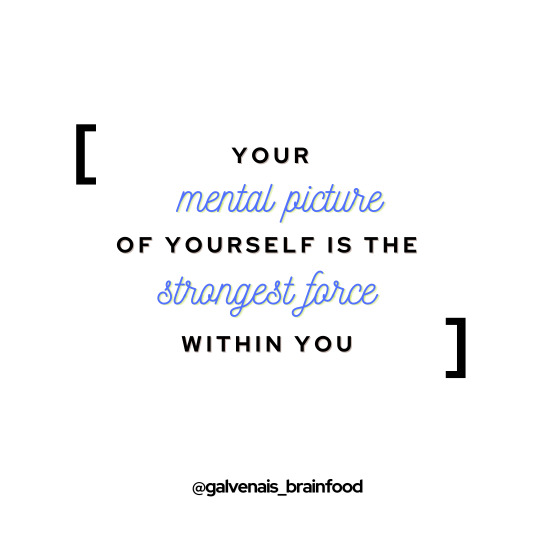
The way you 👀 and IMAGINE 🧘♀ yourself to be is the determining factor of your success or failure in Life.
⚡ ⚡ ⚡
"Tavs mentālais attēls par sevi pašu ir dižākais spēks Tevī"
Tas, kā Tu 👀 un IZTĒLOJIES 🧘♀ sevi esam, būs noteicošais faktors Taviem panākumiem vai neveiksmēm Dzīvē.
#selfimage#self image#mentalpicture#success#imagination#mindpower#power within#galvenais#nutrition#holisticnutrition#healthy foods
3 notes
·
View notes
Text

#healthiswealth#healthyfood#holisticnutrition#holisticnutritionist#healthyeating#holistichealth#healthylifestyle#healthyliving#investinyourhealth#healthyhabits
3 notes
·
View notes
Text
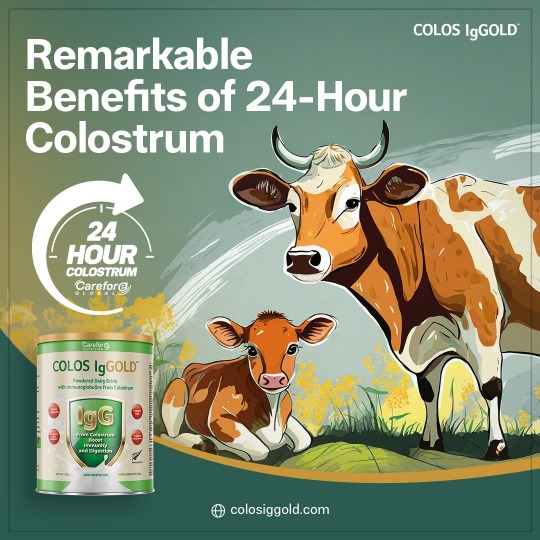
Remarkable Benefits of 24-Hour Colostrum, Essential for Your Wellness Routine:
Enhanced Immunity: Higher Immunoglobulin Concentration.
Revitalize with Abundant Growth Factors.
Enjoy a Nutrient-Rich Bonanza: Enhanced Nutrient Density
Nature's Antibiotic: Elevated Antimicrobial Power.
Optimal Support for Gut Health.
System-Friendly: Reduced Lactose.
#ImmunityBoost#ColostrumBenefits#GrowthFactors#NutrientRich#NatureAntibiotic#GutHealth#LactoseFree#WellnessRoutine#NaturalHealth#HealthyLiving#AntimicrobialPower#Revitalize#NutrientDensity#HealthBonanza#HolisticHealth#OptimalWellness#Immunoglobulin#HealthyChoices#BodySupport#HolisticNutrition#WellnessJourney#NourishYourBody#WellnessEssentials#Nature'sGift#HolisticLiving#HealthyLifestyle
0 notes
Text
Holistic Nutrition 101: A Guide to Wholesome Well-Being
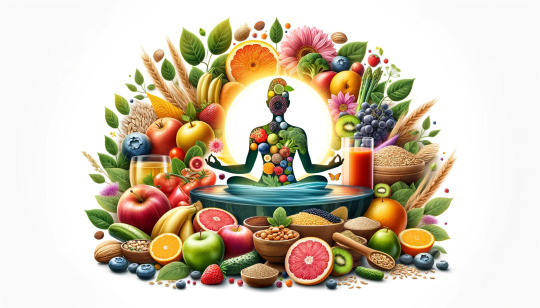
Welcome to "Holistic Nutrition 101" – your gateway to a transformative approach to health and wellness. In a world bombarded by fast food options, quick-fix diets, and a plethora of nutrition myths, the essence of true health often gets lost in the noise. This guide is designed to steer you back to the basics of nutrition — a holistic approach that nourishes not just the body, but the mind and spirit as well. Here, you'll discover how integrating simple, natural foods and mindful eating habits can significantly uplift your overall health. We're not just talking about short-term benefits; we're delving into a way of life that can help you feel more energized, balanced, and in tune with your body's natural rhythms. So, whether you're looking to overhaul your diet, manage a health condition, or simply improve your general well-being, you're in the right place.
Understanding Holistic Nutrition
Holistic nutrition is more than a diet; it's a comprehensive approach to health that views the individual as a complete system — one where physical, mental, and emotional aspects are interconnected and equally important. This approach is grounded in the philosophy that food is not only fuel but medicine, and that what we eat directly affects not just our physical health but our mental clarity, emotional balance, and overall quality of life.
The core principle of holistic nutrition is simple yet profound: eat foods that are as close to their natural state as possible. This means embracing a diet rich in whole, unprocessed foods like fresh fruits and vegetables, whole grains, lean proteins, and healthy fats. It's about prioritizing quality over quantity, understanding the source of your food, and recognizing the impact of your dietary choices on the environment and your health.
In holistic nutrition, every meal is an opportunity to positively impact your well-being. It's not just about avoiding unhealthy foods; it's about actively choosing foods that promote vitality, prevent illness, and enhance your overall life force. This form of nutrition considers individual dietary needs and preferences, making it a highly personalized and flexible approach. Whether you're dealing with specific health issues, dietary restrictions, or lifestyle choices, holistic nutrition can be tailored to meet your unique needs, making it a sustainable and enjoyable path to better health.
Benefits of Holistic Nutrition
Prevention of Chronic Diseases: A diet rich in whole, unprocessed foods is key in preventing various chronic diseases. Holistic nutrition helps maintain a healthy weight, reduces the risk of diseases like diabetes, heart disease, and certain cancers, and supports overall bodily functions.
Improved Mental and Emotional Well-being: What we eat affects not just our bodies but also our minds. A holistic diet, rich in nutrients, can improve mental clarity, mood, and emotional stability.
Energy and Vitality: Holistic nutrition emphasizes foods that naturally boost energy levels and improve metabolism.
Supports Digestive Health: Whole foods, particularly those high in fiber, play a crucial role in digestive health.
Customized to Individual Needs: Recognizing that each individual is unique, holistic nutritionists tailor dietary plans to suit personal health needs, preferences, and lifestyles.
Next, we'll explore practical ways to implement holistic nutrition principles in daily life, making it easier for you to embark on this rewarding journey towards better health.
Implementing Holistic Nutrition in Daily Life
Prioritize Whole, Unprocessed Foods: Start by incorporating more whole foods into your diet.
Hydration is Key: Ensure you're drinking enough water throughout the day.
Mindful Eating: Pay attention to your body's hunger and fullness cues.
Cook at Home: Preparing your meals at home can be a great way to control the ingredients.
Educate Yourself: Understanding the nutritional value of different foods is crucial.
Listen to Your Body: Everyone’s nutritional needs are unique.
Seek Professional Guidance: If you're unsure where to start or have specific dietary needs, consider consulting a holistic nutritionist.
Stay Informed: Educate yourself about holistic nutrition to make informed choices.
Enjoy the Process: Embrace the journey of holistic nutrition and celebrate the positive changes.
The Misunderstanding of Holistic Nutrition
Myth: Holistic Nutrition is Just a Trend: Holistic nutrition is a long-standing approach to eating that focuses on natural, whole foods.
Myth: It's All or Nothing: Holistic nutrition is about making gradual, sustainable changes.
Myth: Holistic Nutrition is Unscientific: Holistic nutrition is grounded in scientific principles.
Limitation: Not a Substitute for Medical Treatment: Holistic nutrition should not be seen as a substitute for professional medical treatment.
Limitation: Accessibility and Cost: Holistic nutrition is adaptable and can be practiced even within these constraints.
Myth: One-Size-Fits-All Approach: Holistic nutrition is highly individualized.
Practical Tips for Embracing Holistic Nutrition
Transitioning to a holistic nutrition lifestyle can be smooth and enjoyable with the right strategies. Here are some practical tips to help you embrace this approach:
Start with Breakfast: Begin your day with a nutritious, whole-food-based meal. Consider options like oatmeal with fresh fruits and nuts, a smoothie packed with greens and seeds, or eggs with whole-grain toast and avocado.
Smart Snacking: Replace processed snacks with healthier alternatives. Try hummus with vegetable sticks, fruit with a handful of nuts, or a small serving of natural yogurt.
Herbs and Spices: Enhance your meals with herbs and spices instead of relying on salt or sugar for flavor. This not only improves taste but also adds nutritional value.
Mindful Grocery Shopping: Plan your grocery shopping list to include more whole foods. Avoid aisles with processed foods and spend more time in the fresh produce section.
Batch Cooking and Meal Prepping: Prepare meals in advance to save time and ensure you have healthy options readily available throughout the week.
Stay Informed About Food Labels: Learn to read and understand food labels to make better choices when shopping for packaged foods.
Hydrate Creatively: If you find plain water unappealing, try infusing it with fruits, cucumber, or herbs like mint for a refreshing twist.
Experiment with Plant-Based Meals: Even if you're not a vegetarian or vegan, incorporating plant-based meals into your diet can add variety and extra nutrients.
Take It Slow: Remember, transitioning to holistic nutrition is a journey. Don’t be hard on yourself for occasional indulgences. It's all about balance and making more healthy choices over time.
Community Support: Connect with others who are interested in holistic nutrition. Join online forums, attend workshops, or find local groups where you can share ideas and get support.
By incorporating these practical tips into your daily routine, you can gradually shift towards a more holistic approach to nutrition, leading to improved health and well-being.
Getting Started with Holistic Nutrition
Assess Your Current Diet: Take a close look at what you're currently eating.
Plan Your Meals: Planning is key in holistic nutrition.
Gradual Changes: Begin with small, manageable changes to your diet.
Stay Hydrated: Proper hydration is essential for digestion, nutrient absorption, and overall health.
Listen to Your Body: Pay attention to how different foods make you feel.
Seek Support: Consider consulting a holistic nutritionist for personalized advice.
Stay Informed: Read books, follow blogs, or join health and nutrition groups.
**Mindful Eating**: Practice mindfulness when eating and listen to your body's cues.
Enjoy the Process: Embrace the journey towards a balanced and healthy lifestyle.
Conclusion
As we wrap up our journey through "Holistic Nutrition 101," remember that the path to well-being is a personal one. Holistic nutrition offers a way to honor your body's needs while nurturing your mind and spirit. It's about making choices that resonate with your individual health goals and lifestyle. Embrace the changes, no matter how small, and trust in the process of nurturing yourself holistically.
We'd love to hear from you! Share your experiences, challenges, or tips in the comments below. Your insights could be incredibly helpful to others and might just be the encouragement someone needs to start their own journey. Let's support each other in our quest for better health and well-being.
Frequently Asked Questions (FAQs)
Q: What are the first steps to transitioning to holistic nutrition?
A: Begin by gradually incorporating more whole, unprocessed foods into your diet, staying hydrated, and being mindful of your body's responses to different foods.
Q: Can holistic nutrition help with specific health conditions?
A: While holistic nutrition can support overall well-being and may help manage certain conditions, it should not replace medical treatment. Always consult healthcare professionals for specific health issues.
Q: Is holistic nutrition expensive?
A: While some aspects, like organic foods, can be more costly, holistic nutrition focuses on whole foods, which can be budget friendly. Planning and smart shopping can help manage costs effectively.
Q: How does holistic nutrition differ from traditional diets?
A: Holistic nutrition considers the whole person - mind, body, and spirit - and emphasizes natural, unprocessed foods, unlike many traditional diets that focus primarily on weight loss or calorie control.
Q: Can I practice holistic nutrition if I have dietary restrictions or allergies?
A: Absolutely. Holistic nutrition is highly individualized and can be adapted to accommodate various dietary needs, including allergies and restrictions.
#HolisticNutrition#HealthyEating#WellnessJourney#WholeFoods#MindfulEating#NutritionTips#CleanEating#NaturalWellness#HolisticHealth#BalancedDiet#EatWellLiveWell#NutritionMatters#FoodAsMedicine#HealthAndWellness#SustainableEating#HolisticLiving#NourishYourBody#HealthyLifestyle#WellnessBlog#NutritionEducation
0 notes
Photo

Holistic Mind-Body Nutrition Guidance: Nourishing Your Total Well-be … https://rntozen.com/blog/mindfulness/holistic-mind-body-nutrition-guidance-nourishing-your-total-well-being
#BalancedLifestyle#EmotionalHealth#HolisticNutrition#MentalClarity#MindBodyWellness#MindfulEating#NutritionGuidance#PhysicalHealth#WellBeingJourney
0 notes
Text

"Meet the powerhouse of nutrition - Moringa Capsules! 🌿 Packed with antioxidants and nutrients, these capsules are your daily dose of wellness. Say hello to a healthier you!
#Moringa#grenera#MoringaCapsules#WellnessJourney#HealthyLiving#Superfood#NaturalHealth#PlantBased#Nutrition#HealthAndWellness#HolisticHealth#CleanLiving#GreenPower#EnergyBoost#ImmuneSupport#FarmToTablet#OrganicLifestyle#Vitality#HolisticNutrition#WellnessWarrior#NaturalEnergy#MoringaMagic
0 notes
Text
Hormone & Heart-Healthy Nutrient-Packed Vegan & Gluten-Free Pumpkin Seeds
Are you ready to embark on a delicious and heart-healthy culinary adventure? Look no further than our Spicy Pumpkin Seeds recipe. Creating these delectable pumpkin seeds is a breeze, and the rewards are immense. Picture this: fresh, crunchy pumpkin seeds kissed with the fiery charm of chili powder or cayenne. They're a savory, crispy delight that not only tantalizes your taste buds but also pampers your heart.
These little seeds themselves are packed with nutrients that support cardiovascular health, from magnesium and potassium to heart-healthy fats. Plus, the optional use of olive oil brings a touch of Mediterranean magic to the mix. So, don't wait any longer. Get your hands on some pumpkin seeds and give this super-simple yet incredibly nutritious recipe a try. Your heart—and your taste buds—will thank you!
What Are Spicy Pumpkin Seeds Made Of?
Spicy Pumpkin Seeds are a simple yet scrumptious snack that combines fresh pumpkin seeds with a touch of olive oil, chili powder (and/or cayenne for an extra kick), and a dash of unrefined sea salt. These ingredients come together to create a flavorful and nutritious treat. This is the perfect healthy snack to make after pumpkin carving!
Customizing your Spicy Pumpkin Seeds is as easy as it is delightful. Besides the classic spicy seasoning, there are numerous ways to tailor this recipe to your taste buds and dietary preferences.
Love Italian flavors? Add an Italian seasoning mix for a Mediterranean twist. Craving some Mexican flair? Sprinkle your seeds with a zesty Mexican blend. For those who prefer an exotic touch, go for a curry or Thai seasoning.
Think of all of the spicy and aromatic combinations you could use! You could add garlic powder, smoked paprika, ground cumin, or even fresh herbs. All of these aromatic herbs and spices add their own anti-inflammatory goodness.
If you have a sweet tooth, consider coating the seeds in a little stevia extract or another liquid sweetener, then dust them with aromatic cinnamon or pumpkin pie spice. It's a delightful contrast to the spicy kick!
For a gluten-free alternative to salt, try wheat-free tamari. It's a flavorful substitute that's sure to tickle your taste buds. If you're looking to boost your nutritional profile, sprinkle some powdered kelp or other sea vegetables over your seeds. These nutrient powerhouses will give your snack an extra health punch.
Finally, for those seeking a savory, cheesy flavor, nutritional yeast is your go-to. This versatile ingredient adds a cheesy, umami richness that's perfect for elevating the taste of your pumpkin seeds. It's high in protein and B-Vitamins. Just make sure to check the ingredients and find a nutritional yeast that doesn’t have added synthetic folic acid. I prefer the unfortified brands.
With these customizable options, you can turn your Spicy Pumpkin Seeds into a truly unique and personalized snack that suits your cravings and dietary needs. Enjoy pumpkin recipes with the freedom to experiment and discover your perfect flavor combination!
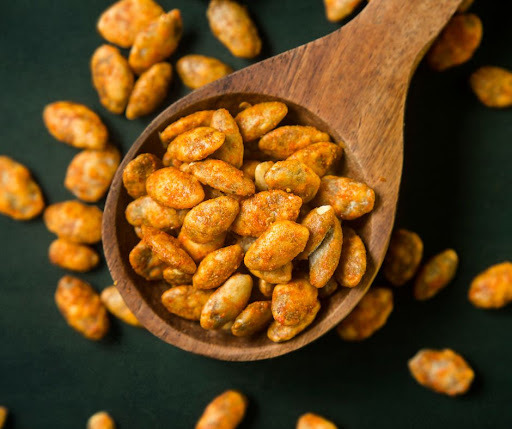
How Do You Make Spicy Pumpkin Seeds?
Making these irresistible Spicy Pumpkin Seeds is as effortless as it is rewarding. Begin by generously coating fresh pumpkin seeds with a touch of olive oil, ensuring each seed glistens with flavor potential. Then, here comes the fun part – add your preferred seasoning. If you crave a spicy kick, opt for chili powder; for those daring souls, a dash of cayenne will ignite your taste buds. Give them all a good, hearty mix to infuse every seed with tantalizing flavors.
Now, the magic unfolds: lay these seasoned seeds gracefully on a dehydrator tray in a single layer where they'll leisurely bask at a cozy 110 degrees. Let them soak up the warmth overnight, perhaps a bit longer if your surroundings are humid.
The result? Exquisite, perfectly crispy Spicy Pumpkin Seeds, ready to elevate your snacking game or become the star ingredient in delightful recipes like pumpkin seed brittle spread pumpkin seeds. Or use them in place of croutons! So many people are looking for gluten-free options for a crispy, crunch on their salads and wraps, this may do the trick!
Prepare to embark on a mouthwatering journey where simplicity meets flavor explosion!

How Do These Ingredients Help with Blood Sugar Balancing and Heart Health?
Spiced Pumpkin Seeds can play a role in maintaining cardiac health while balancing blood sugar due to their nutrient composition. Pumpkin seeds are a good source of heart-healthy fats, fiber, and antioxidants.
The addition of olive oil further enhances the heart-protective properties, thanks to its monounsaturated fats. Plus, these seeds can help manage cholesterol levels, another essential factor in cardiovascular well-being. The absence of unhealthy trans fats makes them a heart-smart, healthy snack option.
Pumpkin seeds are an excellent source of essential minerals like zinc and magnesium, which are involved in hormonal regulation and overall health. Olive oil, rich in monounsaturated fats, supports heart health, reducing the risk of heart-related hormonal imbalances. Moreover, the choice of seasoning, like chili powder or cayenne pepper, has metabolic benefits, aiding in weight management and hormone regulation.
Each ingredient in this delightful recipe plays a unique role in supporting hormone balance, especially concerning blood sugar hormones.
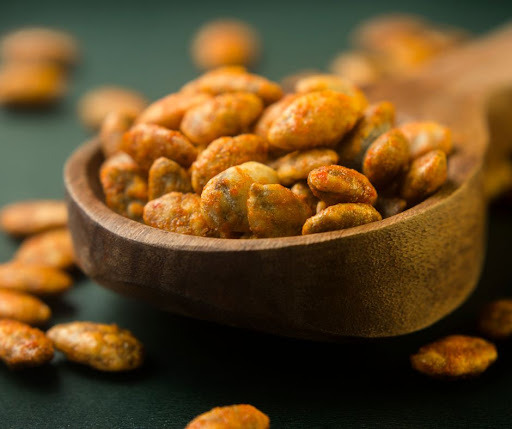
Pumpkin Seeds Are Packed With Nutrition For Heart Health And Hormones
Raw pumpkin seeds are rich in dietary fiber, particularly soluble fiber. Soluble fiber has a unique ability to slow down the absorption of sugar in the digestive tract. By doing so, it helps to prevent rapid spikes in blood sugar levels after meals. This is especially beneficial for individuals with diabetes or those with insulin resistance.
Several components of pumpkin seeds, including magnesium and antioxidants, have been linked to improved insulin sensitivity. Magnesium, in particular, is involved in various insulin-related processes within the body. Therefore, consuming pumpkin seeds can support better insulin function and help manage insulin resistance.
The nutrient composition of pumpkin seeds makes them a heart-healthy addition to your diet, as well. These small but mighty seeds are packed with a variety of nutrients that can positively impact heart health in several ways.
Raw pumpkin seeds are a rich source of magnesium, with just one ounce providing nearly half of the recommended daily intake. Magnesium is crucial for heart health as it helps regulate blood pressure and supports normal heart rhythm. Adequate magnesium intake can reduce the risk of heart disease by helping to keep blood pressure within a healthy range.
Another mineral abundant in pumpkin seeds is potassium. Potassium plays a vital role in maintaining healthy blood pressure levels. It counteracts the effects of sodium, helping to relax blood vessel walls and reduce the strain on the heart. A potassium-rich diet, which includes foods like pumpkin seeds, can contribute to lower blood pressure and a reduced risk of stroke.
Pumpkin seeds are a good source of antioxidants, including vitamin E. Antioxidants combat oxidative stress in the body, which can lead to inflammation and damage to blood vessels. By reducing oxidative stress, antioxidants like vitamin c in pumpkin seeds contribute to heart health.
Zinc, a vital trace mineral abundant in pumpkin seeds, plays a significant role in promoting heart health through various essential functions. One of its primary functions is bolstering the body's antioxidant defense system. By mitigating oxidative stress and inflammation within blood vessels, zinc helps maintain a heart-healthy environment.
Furthermore, zinc contributes to the regulation of blood pressure. It actively supports the production and release of nitric oxide (NO), a molecule responsible for relaxing blood vessels and subsequently reducing blood pressure. This vasodilatory effect eases the workload on the heart and helps maintain optimal blood pressure levels.
Zinc also possesses anti-inflammatory properties, crucial for heart health. Chronic inflammation is a leading factor in the development and progression of cardiovascular diseases. Zinc's ability to mitigate inflammation in blood vessel walls aids in preventing atherosclerosis, the accumulation of plaque in arteries.
In addition, zinc supports immune function, fortifying the body's defenses against infections that might lead to cardiovascular inflammation. Finally, zinc is essential for overall cellular health, as it maintains cell membrane integrity and facilitates DNA replication, all of which contribute to the proper functioning of heart cells.
Balancing zinc intake is key, as excessive amounts can lead to adverse effects. Pumpkin seeds offer a healthy dose of zinc, along with a wealth of other heart-healthy nutrients, making them a valuable addition to a heart-conscious diet.
Olive Oil
Olive oil is a nutritional powerhouse that offers numerous benefits for heart health and blood sugar regulation. Rich in monounsaturated fat, particularly oleic acid, it has been a dietary staple in Mediterranean cultures, which is associated with lower rates of heart disease and diabetes.
First and foremost, olive oil's monounsaturated fats are renowned for their heart-protective properties. These healthy fats help reduce levels of LDL cholesterol, often referred to as “bad” cholesterol, in the blood. Simultaneously, they elevate levels of HDL cholesterol, or “good” cholesterol. This balance promotes healthier arteries by reducing the buildup of plaque and inflammation, thereby lowering the risk of atherosclerosis and heart disease.
Additionally, olive oil is a potent source of antioxidants, such as vitamin E and polyphenols, which combat oxidative stress and inflammation in the body. Oxidative stress can damage blood vessels and contribute to heart disease. The polyphenols found in olive oil have also been linked to improved blood vessel function and reduced blood pressure, further supporting heart health.
In terms of blood sugar regulation, olive oil has a low glycemic index, meaning it has a minimal effect on blood sugar levels when consumed. This quality is particularly advantageous for individuals with insulin resistance and those aiming to prevent blood sugar spikes.
Olive oil also contains compounds that enhance insulin sensitivity, making it easier for cells to respond to insulin and regulate blood sugar effectively. By promoting better insulin function, olive oil contributes to balanced blood sugar levels, reducing the risk of insulin resistance, type 2 diabetes, and related heart complications.
Incorporating olive oil into your diet can be a delicious and health-conscious choice. Its nutrient-rich profile not only supports heart health but also aids in maintaining steady blood sugar levels, making it a valuable ally in overall well-being.
Chili Powder or Cayenne Pepper
Chilies and cayenne peppers, with their fiery heat, not only add a burst of flavor to your dishes but also offer several potential health benefits related to hormones, blood sugar, and heart health.
Chilies contain capsaicin, a phytochemical responsible for their heat. Research suggests that capsaicin impacts hormones, particularly in areas like weight management. Capsaicin can stimulate brown fat, which helps burn calories and regulate metabolism.
Chili peppers, including cayenne, have demonstrated potential in helping manage blood sugar levels. Capsaicin can improve insulin sensitivity, making cells more responsive to insulin. This can be particularly beneficial for individuals with insulin resistance or type 2 diabetes. Some studies suggest that capsaicin may also reduce blood sugar spikes after meals.
Capsaicin also aids in increasing the breakdown of LDL cholesterol, the “bad” cholesterol, in the bloodstream. This can contribute to lower levels of LDL cholesterol and reduce the risk of atherosclerosis (hardening of the arteries).
Capsaicin has been associated with improved endothelial function, leading to better blood vessel dilation and reduced blood pressure. Lowering blood pressure is crucial for heart health and reducing the risk of heart disease.
Chronic inflammation is a risk factor for heart disease. Capsaicin has anti-inflammatory properties that help reduce inflammation in the cardiovascular system.
Maintaining a healthy weight is essential for heart health. Capsaicin can increase metabolism and reduce appetite, which aids in weight management and, subsequently, heart health.
It's important to note that while chilies and cayenne peppers have potential health benefits, the concentration of capsaicin varies between pepper varieties, so the effects can differ depending on the type and quantity of pepper consumed.
Unrefined Sea Salt
The minerals found in unrefined salt can have various effects on heart health and hormone regulation.
Unrefined salt contains more than just the sodium and chloride found in table salt. It contains magnesium and potassium mentioned above, and it is also loaded with other minerals.
· Calcium is necessary for the contraction and relaxation of muscles, including the heart muscle. It also helps with blood clotting. Adequate calcium intake may contribute to overall heart health.
· Selenium is an antioxidant mineral that helps protect cells from oxidative damage. It has a role in reducing inflammation and preventing cardiovascular diseases. Selenium is also associated with thyroid hormone metabolism, which affects metabolism and overall hormone regulation.
· Iodine is crucial for the production of thyroid hormones, which regulate metabolism. Proper thyroid function is important for maintaining a healthy weight and preventing metabolic disorders.
· Zinc plays a role in insulin storage and release in the pancreas. It also contributes to insulin sensitivity, which can help control blood sugar levels. Zinc deficiency may impair glucose metabolism.
· Chromium, although typically found in very small amounts, chromium is involved in insulin signaling and may enhance the action of insulin.
· Copper is essential for the formation of collagen and elastin, which are important for blood vessel health. Adequate copper levels may contribute to maintaining the elasticity and integrity of blood vessels.
Unrefined salt, which contains these minerals in small amounts, can support heart health and hormonal balance. However, it's essential to consume these minerals from a variety of food sources as well, as relying solely on salt for mineral intake may not provide sufficient amounts for optimal health.
Now that you're well-acquainted with the fantastic health benefits that our Spiced Pumpkin Seeds offer, it's time to dive into the kitchen and whip up this tantalizing treat. Imagine the irresistible aroma wafting through your home as these seeds slowly dehydrate, becoming perfectly crunchy and flavorful.
Whether you're craving a nutritious snack or a unique addition to your culinary repertoire, these seeds have got you covered. Don't miss the chance to savor a delightful combination of savory, spicy, and wholesome goodness.
So, let's embark on this culinary journey together, where taste and well-being harmonize in every bite. Grab those fresh pumpkin seeds and let's get cooking!

Spicy Pumpkin Seeds
Ingredients
Fresh pumpkin seeds
1 teaspoon olive oil per 2 cups seeds (optional)
1 teaspoon chili powder and/or 1/4 teaspoon cayenne
1/4 teaspoon unrefined sea salt per 2 cups seeds (optional)
Preparation
1. Use clean pumpkin seeds.
2. Toss the pumpkin seeds with olive oil, sprinkle with seasonings, and mix well.
3. Spread the seeds on the mesh tray, Teflex sheet, or even parchment paper on a tray of your dehydrator and set it to 110 degrees.
4. Dehydrate for 12 – 24 hours or longer, depending on how moist your environment is, stirring occasionally.
Seasoning Options
Add your favorite seasoning mix: Italian, Mexican, curry, Thai. Try to coat the seeds in stevia or another liquid sweetener and sprinkle with cinnamon or pumpkin pie spice. Use wheat-free tamari instead of salt. Sprinkle with powdered kelp or other sea vegetables for extra nutrition. Use nutritional yeast for a cheesy flavor.
If you don’t have a dehydrator, you have 3 options.
1. One is to just pumpkin seeds in a conventional manner, at 350 degrees for a total cooking time of about 20 minutes. Because the pumpkin seeds are high in omega-3 fats, which are very sensitive to heat, this is not the best option.
2. Second is an option if you have a convection oven. Simply set it to 110 degrees put the seeds on a cookie sheet and let it run until the seeds are dried and crunchy.
3. Third option: if you have an oven with a digital temperature setting, you can usually set it as low as 100 or 120. Do that. In a standard oven set to warm and open the oven door a bit periodically throughout the drying process.
Where Can You Find This and other nutritious and delicioyus recipes like it?
You can find this fantastic Spicy Pumpkin Seeds recipe in the book, available on Amazon, “Dr. Ritamarie's Healthy Halloween Treats: Quick Nourishing and Delicious Recipes and Rituals to Delight Kids of All Ages.” This pumpkin seed recipe, along with many other nourishing and delightful treats, can also be accessed in the recipe vault of the Empowered Self Care Lab. It's a great snack that's the perfect addition to your collection of healthy and tasty snacks for any occasion.
Try this collection for additional ideas for preparing nutrient-dense greens and other phytonutrient-rich veggies.
Body Freedom Nutrition Lab
#HormoneHealth#HeartHealthy#PumpkinSeeds#NutrientPacked#VeganRecipes#GlutenFree#PlantBasedNutrition#SuperfoodSnacks#NutritionForHealth#HealthyHeart#VeganSnacks#WellnessJourney#HormoneBalance#HealthyEating#HolisticNutrition
0 notes
Text









About DREAMjunction ~
C U L T I V A T E
Saturday, October 21, 2023:
Dreaming Together
Cultivating Together
Praying Together
Playing Together
One Humanity
One Love
Better Together
Thank you @thrive_with_trish for your intuitive guidance and graceful space holding.
Thank you @soniamolodecky for your Sacred Land Acknowledgement and your important work with @globalindigenoustrust
Thank you @aribeing for your transformational breathwork.
Thank you @chrisassaad for your potent music medicine & voice alchemy.
Thank you @christianzero.com_ for your mesmerizing visual and musical artistry.
Thank you @andrei.limitless for bringing us fresh spring water and magical flute melodies.
Thank you @chefdorisfin for your delicious nutritious food.
Thank you @theeasternbazaar for your magnificent altar.
Thank you @morningdewmeadows for stewarding the land and opening your hearts to this powerful container.
Thank you @sartvostain for your Love and support every step of the way.
Thank you to the volunteers who helped us make this happen despite the cold and other challenges.
Thank you to the entire Symbio commUnity for your Love❣️
It takes a village and here we are😃
Our apologies to those who left before we got around to taking the ‘group’ photo.
Photos by @ruzteruz and @diveshsehgal
Videos by @anastasiyagavrylenko and @breath.heroes
#Symbio_DreamTogether❣️#Symbio_DREAMjunction#MusicMedicine#Breathwork#ERBE#HolisticNutrition#HolisticLiving#ConsciousRetreat#ConsciousCommUnity#CultivateLove#BetterTogether
0 notes
Text
The Step-by-Step Meditation Journey: How to Build Inner Peace

Introduction
Meditation is an ancient practice that has been used for thousands of years to help cultivate inner peace, relaxation, and an overall sense of well-being. In recent years, the practice of meditation has seen a resurgence in popularity as more people recognize the many benefits that it can offer. Meditation can be used to help reduce stress and anxiety, improve concentration, and promote a sense of inner balance and harmony.
The process of meditation involves a journey of self-exploration and self-discovery that can be extremely rewarding and transformative. This journey begins with the decision to make meditation a part of your life and build a foundation for your practice. By creating a sacred space for your practice, developing an awareness of your breath, and learning the differences between guided and self-guided meditation, you can begin to take the first steps on your journey towards inner peace.
Meditation can be beneficial in many ways, from physical health to mental and emotional wellbeing. Regularly engaging in a meditation practice has been shown to reduce stress and anxiety, improve concentration and focus, and promote feelings of joy, contentment, and inner peace. Meditation can also be used to cultivate compassion towards oneself and others, as well as a greater appreciation of life and the world around us.
By taking the time to create a successful meditation journey, you can reap the many benefits that this practice has to offer. In this article, we will explore the various aspects of meditation and discuss how to create the foundation for a successful meditation journey. We will discuss how to create a sacred space for your practice, the importance of breath awareness, the differences between guided and self-guided meditation, and tips for successful meditation. Through this exploration, you can learn how to unlock the power of meditation and truly experience the richness and beauty of this ancient practice.
Creating a Sacred Space
Have you ever wondered why monks and dedicated yogis make such an effort to meditate within a specific space? The answer is the environment itself. When you create a dedicated space for meditation, it helps your practice. Using the same space for meditation each time creates a sense of familiarity and comfort which allows you to enter a meditative state with ease.
What Is A Sacred Space?
A sacred space is a space that has been devoted to a particular purpose. It could be a corner of your bedroom or living room, or an outdoor area that is special to you. The space should be free from distractions, with minimal furniture, and a pleasant atmosphere.
How To Prepare A Space For Meditation
Here are a few tips for creating a peaceful and inviting meditation space:
1. Lighting – Make sure the space is well lit, as this will help you to feel comfortable and relaxed. Avoid any harsh or glaring lights. Candles or dimmed lighting are both great options.
2. Decor – Choose calming colors and decorations that reflect your style and personality, such as a painting, a special rug, or a piece of furniture.
3. Comfort – Make sure the space is comfortable and inviting. Add a meditation pillow or cushion, a blanket, or a cozy chair.
Benefits Of Creating A Sacred Space
There are numerous benefits to creating a sacred space for meditation. Here are just a few:
1. Focused Attention – Having a designated space for meditation helps to keep you focused and allows you to go deeper into the practice.
2. Comfort and Relaxation – Creating a sacred space that is comfortable and inviting helps to create a sense of relaxation and ease, which is necessary for successful meditation.
3. Clarity and Insight – When you meditate in the same space each time, your practice can become more powerful and insightful as you become more familiar with the space and its energy.
4. Setting Intentions – Having a dedicated space for meditation can help to focus your intentions and ensure that the purpose and outcome of each practice is clear.
Creating a sacred space for meditation is a powerful way to deepen your practice and create a sense of peace and calm. By following these tips and creating a comfortable and inviting atmosphere, you can create a space that will help you to reach new depths in your meditation journey.
Breath Awareness and its Vital Role in Meditation
Breath awareness plays a central role in meditation and can be a powerful tool for cultivating inner peace. The practice of breath awareness involves becoming more mindful of your breathing and focusing your attention on the sensation of your breath as it moves in and out of your body. Becoming aware of your breath can help to ground you in the present moment and can be a powerful tool for cultivating self-awareness and stillness.
The key to utilizing breath awareness in meditation is to focus your attention on the sensations of your breath. This requires that you become more mindful of your breathing and observe the movement of air as it enters and exits your body. To help you become more aware of your breath, it is helpful to place your hands on your abdomen and focus on the rise and fall of your chest and abdomen as you breathe. Doing this encourages slow and deep abdominal breathing and helps to reduce stress and anxiety.
When you are aware of your breath, you can use it to enter a meditative state. To do this, you can consciously slow down your breathing and focus your attention on the sensation of your breath as it moves through your body. By doing this, your body will relax and you will begin to enter a meditative state. This can be done either sitting or lying down, and can be done on its own or in conjunction with a mantra or visualization.
The importance of breath for meditation cannot be overstated. Breath awareness helps to bring the mind and body into a state of coherence and can be used to help you cultivate a greater sense of peace and presence. It also helps to reduce stress and anxiety by helping to bring the body and mind into a relaxed state. Finally, breath awareness can help to deepen and sustain your meditation practice, as it provides an anchor for your attention and helps you maintain focus and clarity throughout your practice.
Ultimately, breath awareness is a vital part of any successful meditation journey. Becoming mindful of your breath can help to cultivate inner peace and can be a powerful tool for helping you to relax and enter into a meditative state. Additionally, breath awareness can help to deepen and sustain your meditation practice, as it provides an anchor for your attention and helps you stay focused and relaxed.
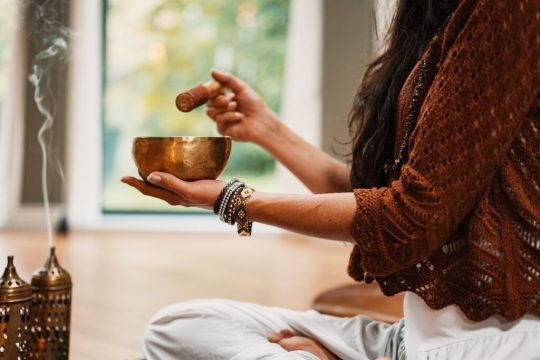
Guided vs. Self-Guided Meditation
When it comes to meditation, there is no one-size-fits-all approach. Different people find different methods more effective, depending on their individual needs and preferences. Whether you are a seasoned meditator or just starting out, it is important to understand the differences between guided and self-guided meditation and how each option can help you create your own unique meditation journey.
The first difference between guided and self-guided meditation is that guided meditation is done with the help of an instructor or facilitator. This person will guide you through the meditation process, providing verbal instruction and cues as well as visual and auditory aids. The benefit of guided meditation is that it facilitates a deep relaxation response and provides structure and support. This can be especially helpful for people who are new to meditation or have difficulty getting started.
On the other hand, self-guided meditation is done without the assistance of an instructor. Instead, you are responsible for setting your own intentions, choosing what type of meditation to practice, and creating your own visualizations. The benefit of self-guided meditation is that it gives you complete freedom to explore different techniques and customize your meditation session to your individual needs.
When it comes to guided vs self-guided meditation, both have distinct benefits. Guided meditation helps give structure to the practice, while self-guided meditation encourages freedom and creativity. Ultimately, it is up to you to decide what type of meditation works best for you.
In terms of the steps involved in each type of meditation, the basic process is the same. You will begin by creating a comfortable, quiet space to meditate. Then, you will focus your attention on your breath, allowing yourself to relax and become more present. Once you reach a calmer state, you can either begin a guided meditation session with an instructor or practice a self-guided meditation technique.
When it comes to guided meditation, the instructor will provide verbal instruction and cues, as well as visual and auditory aids. The instructor will also guide your practice, giving you a roadmap for where to focus your attention. With self-guided meditation, you can explore different techniques at your own pace. You may choose to visualize your breath, practice mindfulness, or explore any other type of meditation technique that resonates with you.
Regardless of which type of meditation you choose, the important thing to remember is that consistency is key. To get the most out of your practice, it is important to stick to a regular schedule and make sure you have enough time to explore and experiment with different meditation techniques. Taking the time to explore guided and self-guided meditation can be a powerful way to deepen your practice and cultivate inner peace.
Tips for Successful Meditation
Meditation is an incredibly powerful tool for achieving inner peace and having a more fulfilling life. However, it is not something that can be mastered overnight and requires patience and dedication. There are many tips that you can follow to ensure that you have a successful meditation journey.
Setting an Intention Before Meditating
Before you begin your meditation journey, it is essential to set an intention. To do this, take a few moments to focus on what it is that you wish to achieve from your meditation session. Consider what it is that you want to bring into your life as a result of your meditation. This could be physical, mental, spiritual, or emotional. By setting an intention, you will be more likely to achieve the desired outcome of the meditation.
Sticking to a Meditation Practice
Once you have set your intention, it is important to establish a daily meditation practice. Even if it’s only for a few minutes each day, it is important to keep up your practice in order to ensure that you make progress in your journey. Try to make it a habit and instead of seeing it as a chore or something that you have to do, view it as an opportunity to give yourself time and space.
Letting go of Expectations
It is also important to remember to let go of expectations. Everyone’s experience of meditation is different, so try not to compare yourself to anyone else. It is also essential to be patient, as it may take some time before you start to experience the full benefits of meditation.
Trying Different Techniques
There are many different techniques in meditation, so it can be helpful to try out different approaches to find what works best for you. Experiment with different poses and breathing techniques until you find what is most comfortable for you. Additionally, there are many guided meditations available online and on streaming services that can help to get you started.
Making Time to Meditate
Finally, it is important to make time for your meditation practice. It is easy to get caught up in life and neglect to take care of ourselves. Take the time each day to give yourself a few minutes of inner peace and quiet. This will help to ensure that you have a successful meditation journey.
By following these tips, you will be able to create a successful meditation journey. From setting an intention before meditating to making the time to practice, these tips will help to ensure that you make the most of your meditation journey. With patience and dedication, you will soon be on your way to achieving inner peace and a more fulfilling life.

Conclusion
Meditation is a journey that can transform your life and bring inner peace and balance. With the right steps, anyone can make their meditation journey successful.
The first step is creating a sacred space, which can help you feel more connected and comfortable with your practice. This space should be free of distractions and have calming elements that help you achieve a meditative state. Once the space is prepared, you can begin to focus more on your breath. Breath awareness is essential for meditation, as it allows you to become more present and mindful. Additionally, it can help you enter and maintain a meditative state.
To make the most out of your meditation journey, you can also choose between guided and self-guided meditation. Guided meditation allows you to be guided by someone else, while self-guided meditation involves setting your own intention and practice. Both have their benefits, so you can select the one that is best for you.
Finally, to ensure success in your meditation, it is important to set an intention before meditating, stick to a routine, and let go of expectations. Every meditation is unique and requires patience and self-compassion.
In conclusion, meditation can be an incredibly powerful and transformative journey. By creating a sacred space, focusing on your breath, understanding the difference between guided and self-guided meditation, and setting an intention, you can start to make your meditation journey successful and find inner peace.
Join the Realty Banker Network and stay ahead of the competition. Connect with us on
Youtube, Facebook, TikTok, Instagram and Twitter. We hope to see you there.

Read the full article
#AlternativeMedicine#AyurvedicMedicine#ChakrasandEnergy#ChineseMedicine#DailyYogaPractice#EmotionalWell-Being#HolisticHealth#HolisticNutrition#IntuitiveLiving#MeditationforWellness#Mind-BodyConnection#Mindfulness#Plant-BasedDiet#RelationshipWellness#SpiritualGrowth#StressManagement#TherapeuticMassages#VeganNutrition#YogaandFitness
0 notes
Text
0 notes
Text

FREE COURSE: Foundations of Holistic Nutrition
Are you tired of fad diets and quick fixes that never seem to stick? Do you want to take a more holistic approach to your health and wellness? If so, the Foundations of Holistic Nutrition course is for you! JOIN NOW!
#naturalhealth#herbalremedies#alternativemedicine#naturalremedies#herbalsupplements#healthydiet#holisticnutrition#holistichealth#freecourse
0 notes
Text
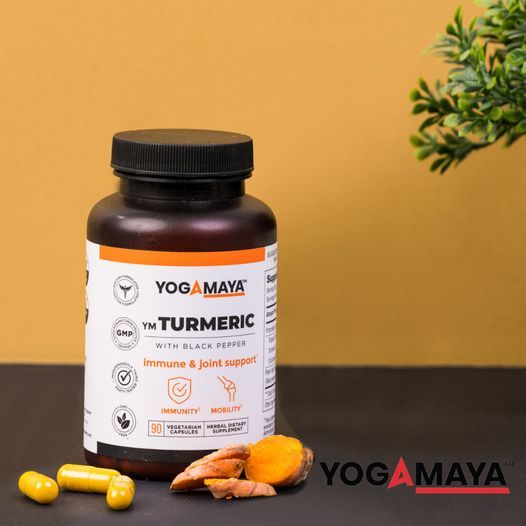
YogamayaTurmeric-YogamayaHealth
Our Turmeric Curcumin is one of our best selling products. But this doesn’t come as a surprise. Turmeric has many benefits, from improving brain function to strengthening the immune system. If you’re looking to improve your quality of life without the harmful side effects of medications, YM Turmeric Curcumin with Black Pepper is a perfect choice!
For more info : [email protected]
#naturalsupplements#naturalsupplementsthatwork#Ayuverda#ayuverdic#ayuverdalife#ayuverdicmedicine#holistichealth#holistichealing#holisticwellness#holisticnutrition
0 notes
Photo

Ready to get back to your regular lifestyle and enjoy life again. You no longer need to worry about the pain and discomfort of indigestion any more. This course is full of amazing healthy clean recipes and yoga videos to help support each phase. Sign up today and see the results as soon as 3 days! Link is provided on my linktree 🔗 If you have have purchased this course, I would love to hear how it worked for you and how long did it take you to see results! #infigestion #bloatedbelly #debloat #10daybellyslimdown #10daybellybloatdetox #resetyourgut #guthealth #healyourgut #kamalaingrid #theholisticyogi #holisticnutrition #eatclean #healthyrecipes #healyourgutwithfood (at Fort Lauderdale, Florida) https://www.instagram.com/p/CpbGtV6L8sJ/?igshid=NGJjMDIxMWI=
#infigestion#bloatedbelly#debloat#10daybellyslimdown#10daybellybloatdetox#resetyourgut#guthealth#healyourgut#kamalaingrid#theholisticyogi#holisticnutrition#eatclean#healthyrecipes#healyourgutwithfood
0 notes
Photo

Benefits of Mindful Eating: Transforming Your Relationship with Food https://rntozen.com/blog/mindfulness/benefits-of-mindful-eating-transforming-your-relationship-with-food/
#ConsciousEating#EmotionalWellness#HealthyEatingHabits#HealthyMindBody#HolisticNutrition#MindfulDiet#MindfulEatingBenefits#MindfulLifestyle#NutritionalAwareness
0 notes
Photo

💯💯💯Truth...sad but true...learn the holistics... #holistichealing #holistichealth #holisticnutrition #holisticwellness #higherfrequency #highervibration #raiseyourvibration https://www.instagram.com/p/Co4ta2_AqoP/?igshid=NGJjMDIxMWI=
#holistichealing#holistichealth#holisticnutrition#holisticwellness#higherfrequency#highervibration#raiseyourvibration
0 notes
Photo
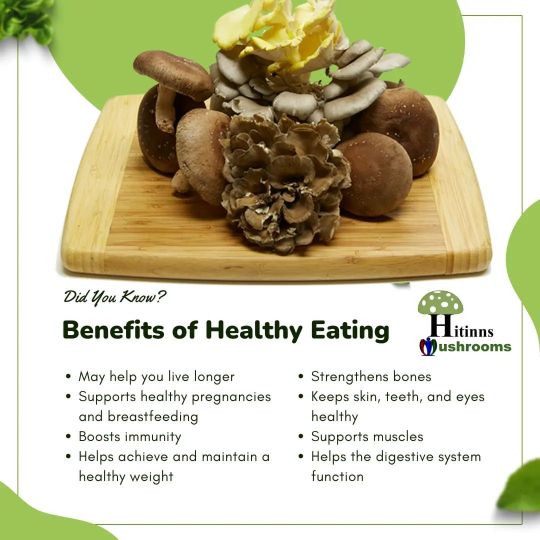
Can I eat mushrooms every day? You can. Mushrooms are incredibly healthy and contain many of the nutrients our bodies need to function well. So, like most things, mushrooms can be eaten often as part of a balanced diet. . . . . . #nutrition #herbalifenutrition #nutritionist #nutritioncoach #holisticnutrition #optimumnutrition #sportsnutrition #nutritiontips #tiunutritionplan #plantbasednutrition #nutritional #sportnutrition #nutritionfacts #1upnutrition #nutritioniskey #5percentnutrition #nutritionable #nutritionplan #questnutrition #nutritionalcleansing #scitecnutrition #healthynutrition #nutritioncoaching #nutritionaltherapy #vegannutrition #holisticnutritionist #goodnutrition #fitnessnutrition https://www.instagram.com/p/CoW9WjPSzCP/?igshid=NGJjMDIxMWI=
#nutrition#herbalifenutrition#nutritionist#nutritioncoach#holisticnutrition#optimumnutrition#sportsnutrition#nutritiontips#tiunutritionplan#plantbasednutrition#nutritional#sportnutrition#nutritionfacts#1upnutrition#nutritioniskey#5percentnutrition#nutritionable#nutritionplan#questnutrition#nutritionalcleansing#scitecnutrition#healthynutrition#nutritioncoaching#nutritionaltherapy#vegannutrition#holisticnutritionist#goodnutrition#fitnessnutrition
0 notes